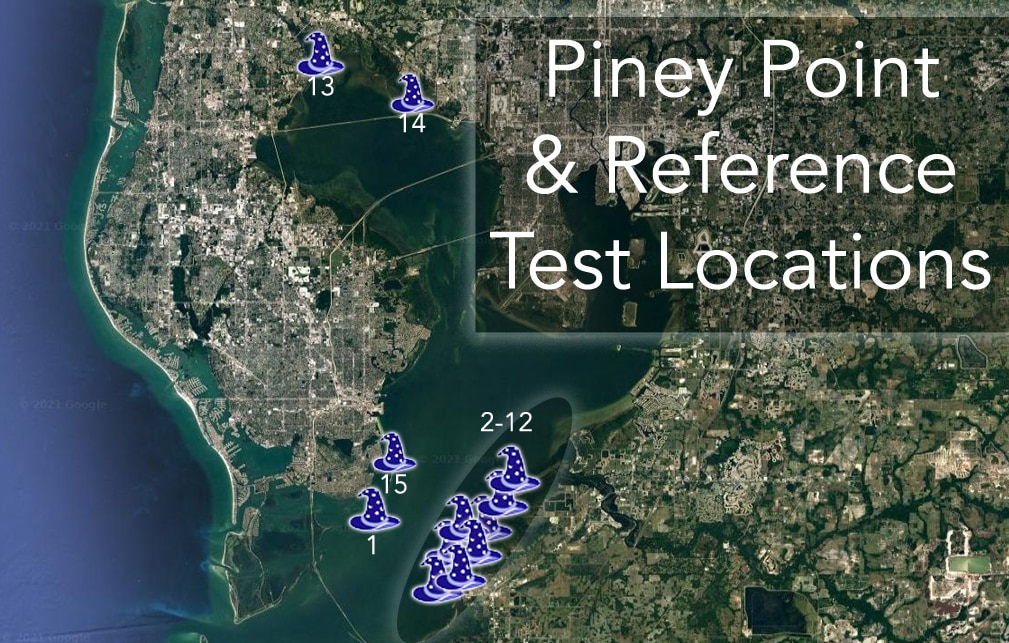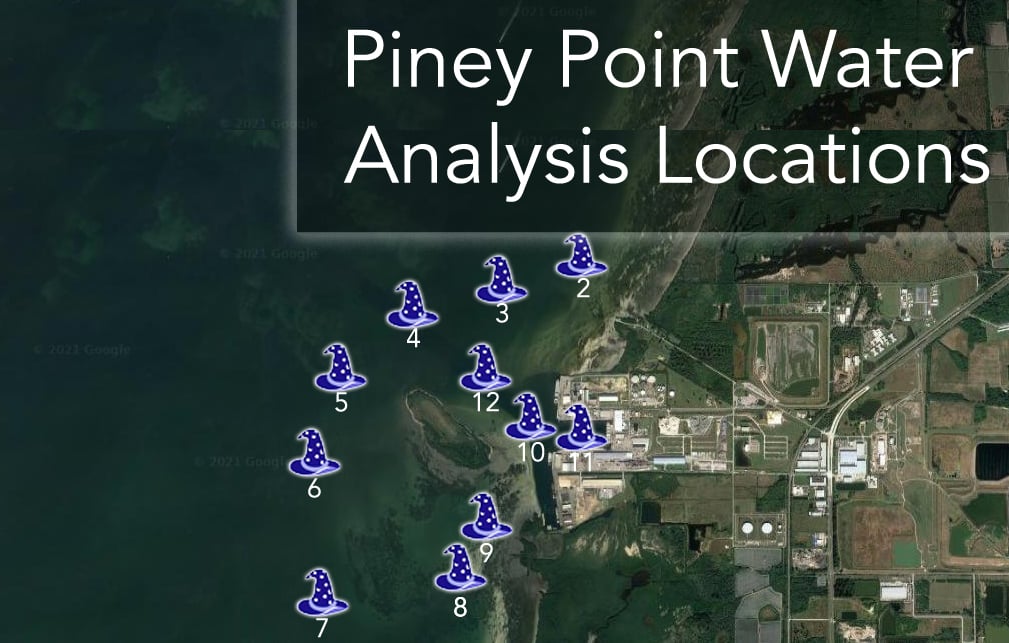The StellarNet Team collected and tested water samples near the Piney Point wastewater leak in Tampa Bay last week- April 9th, 2021. Using their portable UV-VIS spectrometers and NECi enzyme based phosphate and nitrate test kits, they were able to gather real-time data on the pollution into the bay. Overall, water samples from the area around Piney Point measured 2–6 times more phosphate than other parts of the bay! Check out the results below and follow StellarNet on Linkedin or Facebook for future updates.
Local News Link – Tampa Bay Watch monitoring impacts from Piney Point (baynews9.com)
The StellarNet Team has decided to go aquatic this month. With spring beginning and the month of April being home to Earth Day, our team at StellarNet wanted to research some environmental applications. While doing so, a significant environmental event happened. One of Florida’s many phosphogypsum stacks sprung a leak – possibly contaminating our local waters while also being a risk to residents for major flooding. The StellarNet team took to the sea on Friday, April 9th to collect water samples in various parts of the bay to test for Phosphate and Nitrate contaminants.
About Phosphate Mining
Across the state of Florida, there are 27 phosphate mines. Of these, only 9 are active. The mining of phosphate is a large industry – with 90% of the phosphate in the United States being mined in Florida, North Carolina, and Tennessee (according to the EPA). Phosphate rock contains phosphorus which is primarily used to produce fertilizers for agriculture. The type of fertilizer that is created is diammonium phosphate (DAP) which is created by combining ammonia with phosphoric acid. The byproduct of this reaction is called phosphogypsum. Phosphogypsum is similar to natural gypsum but it contains a small number of radioactive minerals that naturally occur in Florida phosphate rock. Because of the radioactive nature of this byproduct, it is unable to be used in other applications so it is stored in stacks along with the wastewater from the process. These stacks of phosphogypsum and retention ponds of wastewater sit, awaiting purification, novel use, or inevitable radioactive decay.
Disaster at Piney Point
One of these phosphogypsum stacks is located in Manatee County, Florida is known as Piney Point. Miles away from Tampa Bay’s local aquatic preserves and estuaries, the Piney Point stack began leaking at the end of March 2021. To stop a possible breach that would flood nearby homes, workers at the site began pumping millions of gallons of the wastewater into Tampa Bay. This was done to reduce the amount of pressure on the walls of the stack so that a larger leak or breach would not happen. According to the Florida Department of Environmental Protection, the wastewater is not radioactive. The water being pumped is actually a mixture of saltwater, stormwater, and water that was leftover from operations of the plant. According to officials – the water meets water quality standards for marine waters with the exception of pH, total phosphorus, nitrogen, and ammonia nitrogen.
Pollution in Tampa Bay
There are many concerns with the amounts of phosphorus and total nitrogen that are being dumped into the bay. The nutrients that are in this wastewater can feed algae that cause algae blooms that could lead to red tide. Red tide is a phenomenon that happens when a harmful algal bloom multiplies in very high concentrations. One of the most well-known algae types for this is Karenia Brevis which causes discoloration of the water. These blooms lead to the mass death of fish, birds, and other wildlife. Humans are affected as well – from tourism and even respiratory irritation. While a red tide is happening, fewer people go to the beach or waterfront restaurants, hurting an already down economy in the current state.
Piney Point Water Results – 4/9/21
The StellarNet team collected 12 samples from a variety of different locations surrounding the Piney Point leak as well as 4 reference samples from other parts of Tampa Bay. After collecting the samples, we used phosphate and nitrate test kits from NECi. These kits use different enzyme-based reagents (non-toxic) to cause either a color change in the sample or a change in the absorbance at a certain wavelength. We did these tests initially on the boat using our zAP2 WiFi-enabled BLUE-Wave spectrometer and our ChemWiz mobile app (available for iPhone and Android). While we did not find increased levels of nitrate, we did; however, find elevated results for phosphate in the area close to the leak. We brought the water samples back to our lab and re-measured the samples with a second batch of reagents to validate our findings.
Piney Point Water Analysis by Location (mg/L P)
| Tampa Bay Location | Phosphate (mg/L P) |
|---|---|
| #1 (Coquina Key reference) | 0.167 |
| #2 | 0.86 |
| #3 | 0.712 |
| #4 | 0.80 |
| #5 | 0.69 |
| #6 | 0.495 |
| #7 | 0.489 |
| #8 | 0.249 |
| #9 | 0.59 |
| #10 | 0.61 |
| #11 | 0.69 |
| #12 | 0.47 |
| #13 (Rocky Point reference) | 0.148 |
| #14 (Safety Harbor reference) | 0.167 |
| #15 (Coquina Key reference) | 0.124 |
Overall, we found that the water samples from the area around Piney Point measured 2 – 6 times the amount of phosphate that was measured in other parts of the bay. We used reference samples taken from Coquina Key, Safety Harbor, and Rocky Point areas; all a significant distance from the leak. By looking at the absorption plot above you can see the small absorption spectrum of phosphate from the reference locations compared to the larger absorptions found directly off Piney Point.
Please understand our StellarNet team is a group of spectroscopists, electric, and optical engineers. We are not marine biologists. Our reference location data does correspond properly with mean annual data for concentration P reported by the Manatee County Water Atlas (Middle Tampa Bay | Bay Details – Manatee.WaterAtlas.org (usf.edu)).
The samples were taken on the last day of the leak, presumably having time to accumulate the highest concentration of pollution. Samples were collected on an incoming tide possibly giving an explanation as to why samples 6,7,8,9 south of Port Manatee are lower in concentration while areas slightly north 2,3,4 have higher concentration P.
Our team plans to revisit the test locations in a few weeks to see how much of the excess P has diffused into the surrounding bay and gulf waters. Follow StellarNet on Linkedin or Facebook for all the updates.








